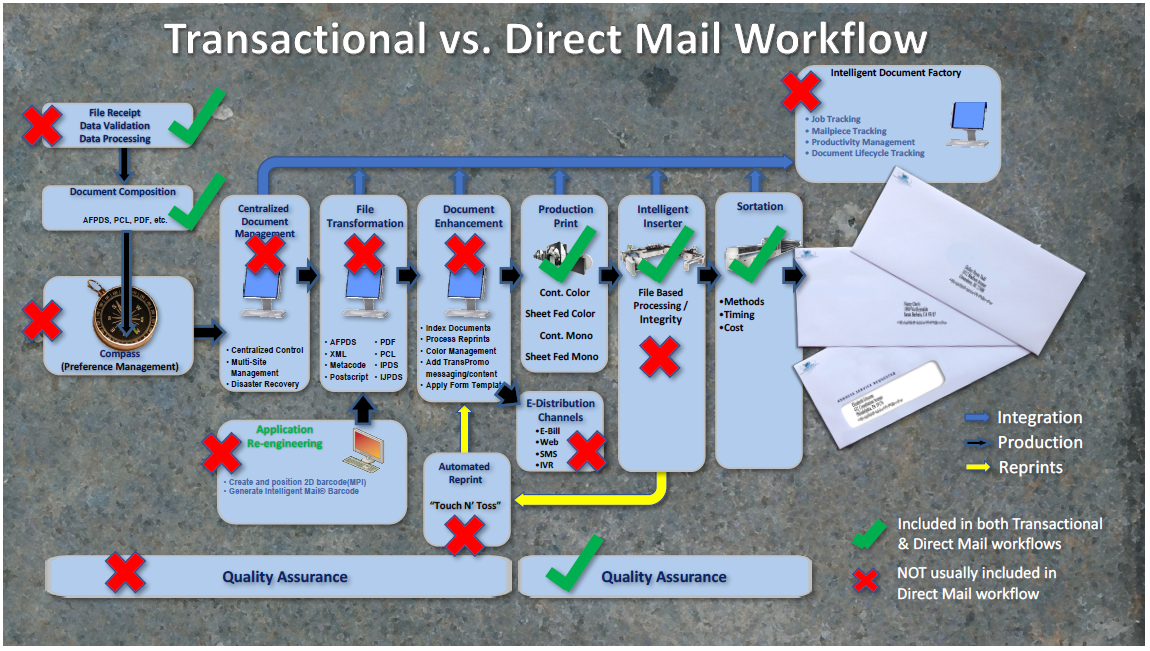This article originally appeared in the May/June, 2018 issue of Mailing Systems Technology.
When internet advertising began to take off and the economy dipped, many direct marketing companies began to look for other ways to leverage their infrastructure as marketing budgets were cut. One of the apparently easy options was to enter the transactional mail space. These direct marketing companies compared their workflows, equipment, employees, suppliers, and USPS knowledge to those needed in transactional mailing, and many determined that the leap into transactional mail was not too great.
However, as many of these companies have learned, although transactional mail looks like direct mail, processes like direct mail, and may quack like direct mail…. it is not direct mail. Transactional mail has many of its own unique idiosyncrasies than are readily apparent from a cursory review of merely the print, insert, and mail workflow.

Although there are many operational differences between transactional and direct mail, these are the major ones to consider:
PROJECT-BASED VS. FULFILLMENT
Most direct mail jobs are project-based, meaning that they have a definite start and end and are unique in their job requirements. Most transactional mail is an ongoing process (i.e. daily, weekly, monthly) and follows the same business rules and processes each time. Accordingly, while most direct mail data files are still handled manually through the data processing stages, transactional mail files are widely automated from file receipt to print queue. This automation requires not only more time and focus to set up, but also a system that can efficiently process files without any human intervention.
MAIL PIECE INTEGRITY
Ah, the perfect piece. Although high quality has always been a focus in direct mail, quality has usually been concentrated on the data side rather than the production side (i.e. print and mail). In fact, where 100% mail is a chargeable option in direct mail, it is inherent in the transactional mail process.
Mail piece integrity is, simply put, ensuring the right document gets into the right envelope. Using the least complex and costly method, this is usually achieved by manual tracking of piece counts from print to insert stations and then piece count reconciliations after the job has been inserted. However, this does not ensure that all the documents in an envelope are correct. Higher-level integrity is achieved by using barcodes on documents for accumulation and tracking, leveraging photocells disposed at periodic and/or critical locations to ensure that each document sheet/set is identified and tracked along the inserter feed path, and implementing a file audit process that electronically reconciles the insert job against the production file. As you may imagine, the mail piece integrity must be managed by an integrity platform designed appropriately for piece-level tracking.
Mail piece integrity leads into the dreaded reprint process. Ideally, transactional mailers will adopt a touch-and-toss process whereby a piece is destroyed if any person handles any sheet within the envelope, thereby eliminating any chance of human error. The destruction of these pieces results in the reprinting of these documents to ensure 100% mailing. As the touch-and-toss process is adopted to eliminate human intervention, a reprint process that is managed off-line by an individual is counterintuitive to this initiative. As such, many transactional mailers develop an automated reprint process where the system can identify all pieces that were not successfully inserted and create a reprint file that would be staged in the standard print queue and follow the normal production process.
DIRECT LABOR
Due to the irregular production volume and schedules of direct mail, most direct marketing companies leverage temporary employees to optimize direct labor management and flexibility. Although temporary employees are perceived to have less loyalty and devotion to the employer due to the sheer nature of the temporary employment relationship, these employees have worked out well due to the quality tolerances understood in direct mail.
However, due to the zero-tolerance associated with transactional mail and the ongoing knowledge and understanding of repeatable work, temporary employees are usually not used, since having “skin in the game” is critical in achieving the high level of quality required. Obviously, having full-time operators introduces its own challenges as it relates to labor management during both slow times as well as very busy times.
PRICING
Most direct marketing jobs are priced on an à la carte basis. Pricing for transactional mail jobs is usually bundled as a core package that would include, for example, data processing and one simplex sheet with a reply envelope into a #10 envelope. Ancillary add-on pricing for additional pages, color, etc. would be separate.
However, the most significant pricing difference relates to postage. In direct mail, postage costs are determined by each individual file after it is processed through presort software. In other words, the postage cost is driven by the individual file saturation.
However, for most transactional work, postage cost per piece is established at a fixed rate… and guaranteed. The reason behind this is because presorting and tracking each individual transactional mail file is administratively burdensome, many transactional mail files lack volume and saturation to achieve postal discounts alone, and most transactional mailers leverage third-party presort services, which provide fixed piece pricing to the mailers.
SERVICE-LEVEL AGREEMENT
In direct mail, we develop a schedule for our customers and require our customers to meet certain deadlines or risk their job being delayed. Usually, this schedule from file receipt to mail drop spans anywhere from seven to 10 days. This allows us to plan and schedule… or reschedule.
In transactional mail, most customers demand 24-hour turnaround and cannot provide volumes for any given day. This requires transactional mailers to be reactionary and able to maintain sufficient resources to complete any volume that may be thrown at them. Although some transactional mailers develop certain volume boundaries for medium and large customers, accurate real-time dashboard reporting of in-bound volume and job batching is critical for meeting transactional service level agreements (SLAs).
WORKING CAPITAL REQUIREMENTS
Historically, most direct marketing companies have required all postage deposits before any job is mailed. This has significantly eliminated or reduced the working capital requirements since the direct mailer does not have to front any postage for customers.
On the other hand, postage deposits for transactional mail are an ever-evolving conundrum. Many transactional mailers require a 45-day postage deposit using the average postage to be used over that period. However, with days sales outstanding (DSOs) creeping up to 45 or 60 days after the actual invoice date, which is usually 10-15 days after month end, transactional mailers could effectively be fronting 45 or 60 days of postage for customers.

Although the above differences may seem overwhelming, the current technology, software, and equipment in today’s market can provide solutions to all the above. More importantly, although direct marketing companies need to be cognizant of these challenges, they should consider themselves fortunate that they already have most of the key pieces and infrastructure needed to make the transition from direct mail to transactional mail… which is more than half the battle!
Ed Horowitz is a CPA by trade and began his career with Price Waterhouse before entering the direct marketing industry as a finance/operations executive with Direct Group. After leaving Direct Group, he became the COO of PSC Info Group (which later became RevSpring), a leading transactional communications company specializing in Healthcare and ARM (collections). After the sale of PSC, Mr. Horowitz started Commogma, a consulting company that specializes in both the Direct Marketing and Transactional space. You can reach him at ehorowitz@commogma.com.










